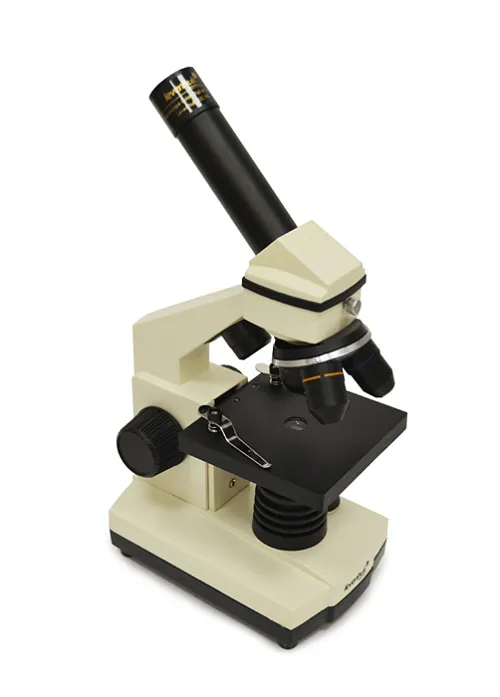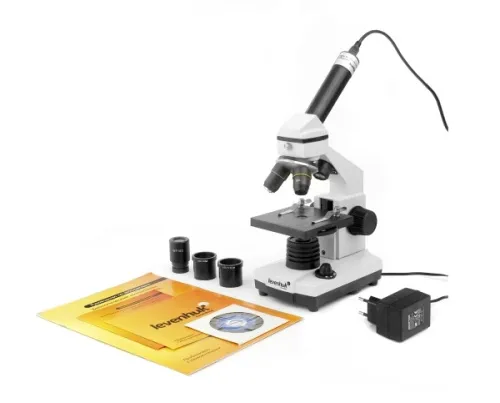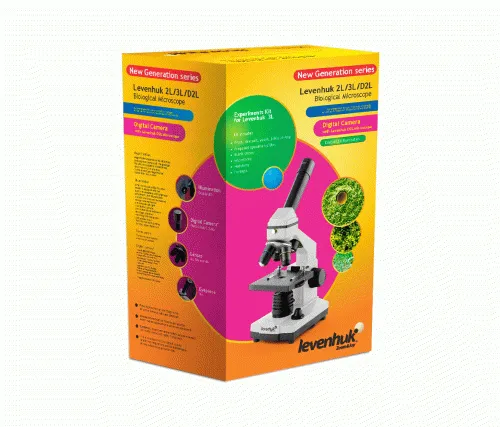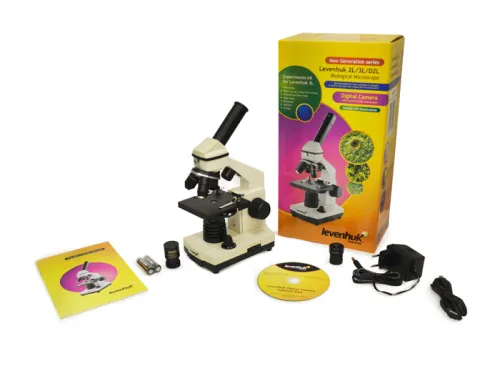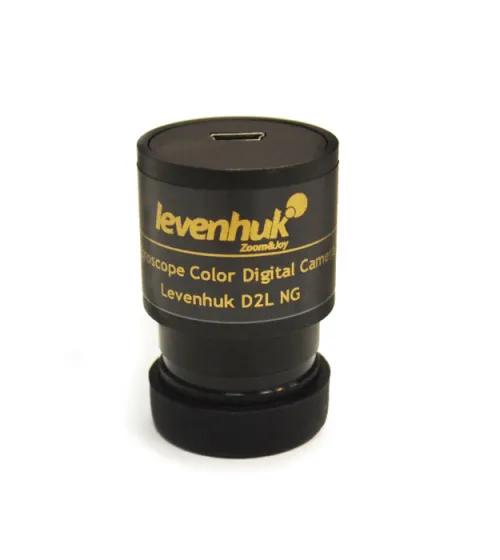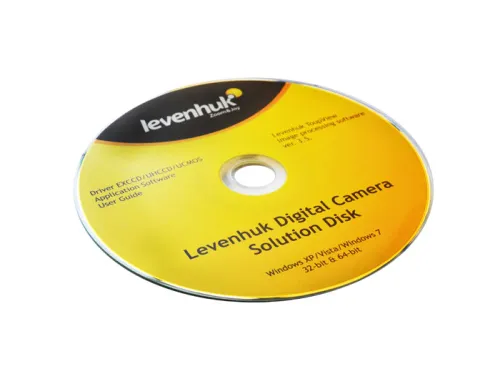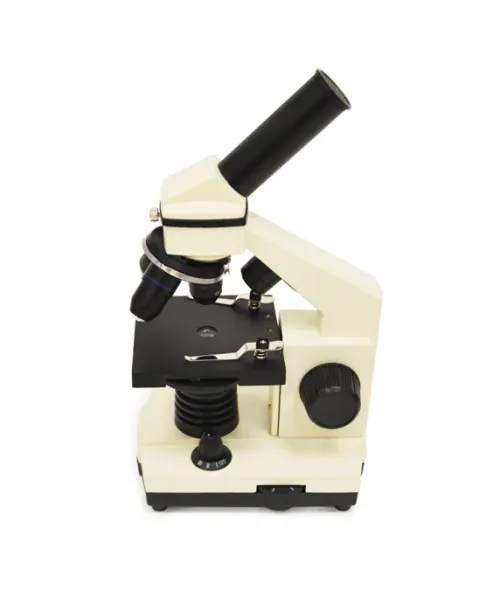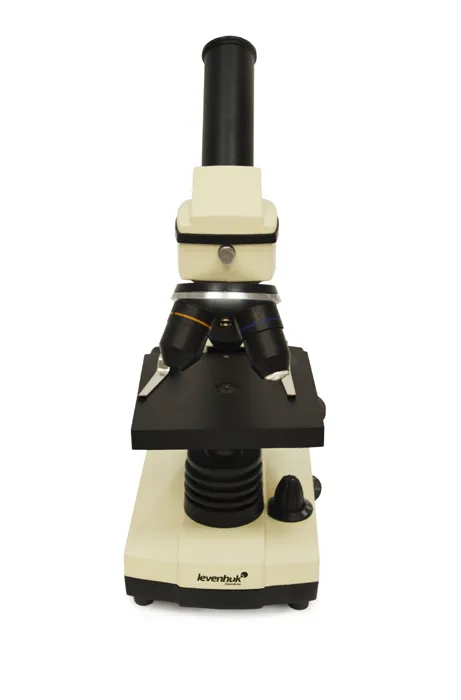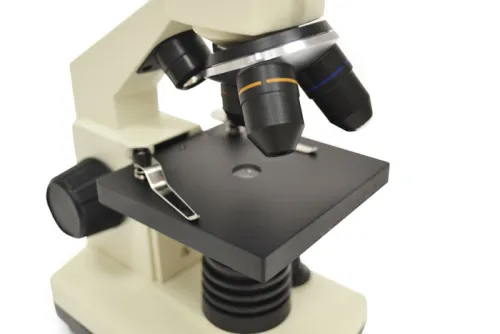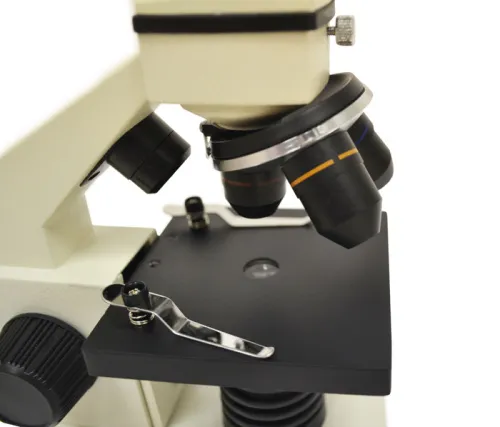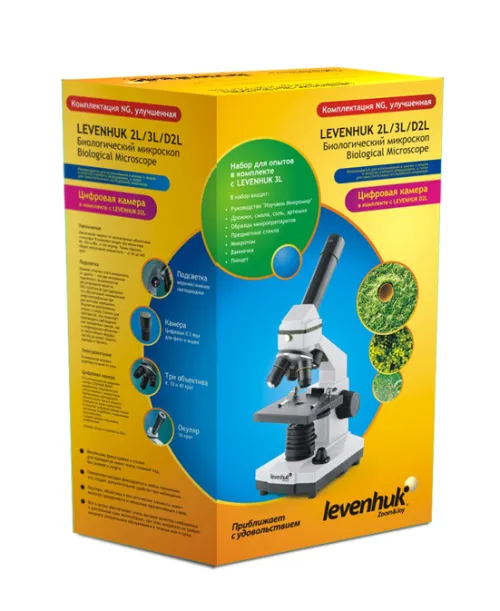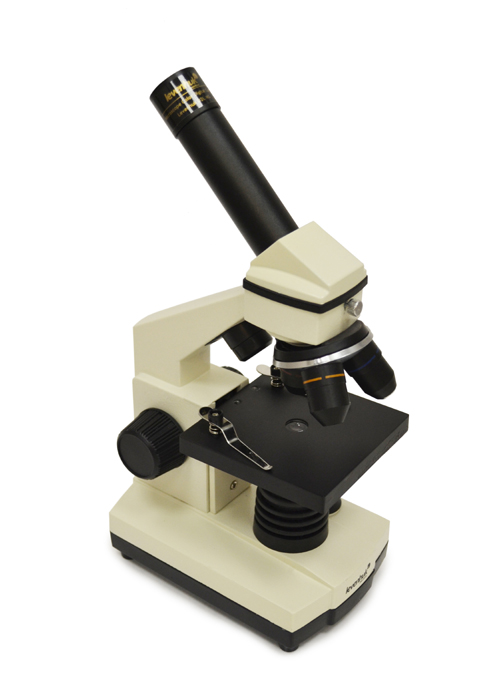Levenhuk D2L NG Digital Microscope
Teaching digital microscope for the beginners, resolution 350 000 pixels
| Product ID | 24612 |
| Brand | Levenhuk, Inc., USA |
| Warranty | lifetime |
| EAN | 2400000000099 |
| Package size (LxWxH) | 13x18x32 cm |
| Shipping Weight | 1.7 kg |
The Levenhuk D2L NG Digital Microscope allows you to undertake high-quality research and take photos/videos of your observations as well. This model can be connected to a PC using USB interface, the software is included in the package. This microscope is designed to ensure the best possible color rendition of photo and video images, and allows you to view real color images.
The Levenhuk D2L NG was developed for use in schools, colleges and universities. This model features glass optics, unlike the less expensive analogs. The main advantage is two sets of illumination (upper and lower), which allow observing both slices and non-transparent objects (from the tiniest solid particles to coins, etc.). Apart from observing and image capturing on the PC screen, it is also possible to make observations in the visual mode without a camera, since eyepiece (WF16x) is included in the package. The Levenhuk D2L NG Digital Microscope is widely used in various educational institutions.
A USB cable is used as camera power supply and for connection with a PC. Compatible OS: Windows 2000/XP/2003/Vista/7/8/10.
Observing non-transparent objects
The Levenhuk D2L NG Digital Microscope, unlike other teaching microscopes, is equipped with two built-in illuminations. Both illuminations are LED, which ensures minimal energy consumption yet provides sufficient light. Illumination systems are located above and below the stage, and allow observing both transparent and opaque objects.
Power supply
The microscope features an AC adapter, for stationary observations without batteries.
Caution: Please refer to the specifications table for the correct mains voltage and never attempt to plug a 110V device into 220V outlet and vice versa without using a converter. Remember that mains voltage in the U.S. and Canada is 110V and 220–240V in most European countries.
The kit includes:
- Microscope
- Monocular head
- Objectives: 4x, 10x and 40x
- Eyepiece: WF16x
- Diaphragm disk
- Stage with clips
- Built-in upper and lower illuminations
- Digital camera Levenhuk D2L (0.3 Mpx)
- SETUP CD Levenhuk ToupView (auto setup guide, drivers, software for image visualization, fixation and processing)
- USB cable
- AC adapter
- 3 AA batteries
- User manual and lifetime warranty
The latest version of Levenhuk ToupView software for Windows (release date: 11/20/2013) supports eight languages: English, French, German, Polish, Russian, Simplified Chinese,Traditional Chinese, Turkish.
Some things you can see under a microscope:





Levenhuk D2L NG Digital Microscope is also compatible with Levenhuk digital cameras (additional cameras are purchased separately). Levenhuk cameras are installed in the eyepiece tube instead of an eyepiece.
Microscopes Comparison Table
| Levenhuk D2L NG Digital Microscope | Levenhuk D50L NG Digital Microscope | Levenhuk D70L Digital Biological Microscope | |
|---|---|---|---|
| Head | monocular | monocular | monocular |
| Video recording | yes | yes | yes |
| Maximum resolution | 640x480 | 1600х1200 | 1600x1200 |
| Megapixels | 0.3 mpx | 2 mpx | 2 mpx |
| Head | rotatable | rotatable | not rotatable |
| Barlow lens | no | 2x | no |
| Objectives | 4х, 10х, 40х | 4х, 10х, 40х | 4х, 10х, 40х |
| Eyepieces | WF16х | WF10x, WF16x | WF10x |
| MAX magnification, x | 640 | 1280 | 1600 |
| Stage, mm | 90x90, with stage clips | 90x90, with stage clips | 90x95, coordinate moving stage with clips |
| Stage moving range, mm | from 0 to 10 | from 0 to 15 | from 0 to 10 |
| Brightness adjustment | yes | yes | yes |
| Dust cover | no | yes | yes |
| Case | no | yes | yes |
| Upper illumination | fixed | retractable | fixed |
| Lower illumination | fixed | fixed | fixed |
| Body | silumin | metal | metal |
| Eyepiece tube | metal | metal | plastic (LCD display) |
| Illumination power supply | AC adapter, batteries | AC adapter, batteries | AC adapter, batteries (not included) |
| Camera power supply | USB cable | USB cable | USB cable |
| Levenhuk K50 Experiment Kit | no | yes | yes |
| "Attractive Microscope. Scrutinizing the Microcosm" User Guide | no | yes | yes |
| Forceps | no | yes | yes |
| Hatchery for brine shrimp | no | yes | yes |
| Microtome | no | yes | yes |
| Flask with yeast | no | yes | yes |
| Flask with pitch | no | yes | yes |
| Flask with sea salt | no | yes | yes |
| Flask with brine shrimp | no | yes | yes |
| Ready specimens | no | yes | yes |
| Blank slides (5 pieces) | no | yes | yes |
| Product ID | 24612 |
| Brand | Levenhuk, Inc., USA |
| Warranty | lifetime |
| EAN | 2400000000099 |
| Package size (LxWxH) | 13x18x32 cm |
| Shipping Weight | 1.7 kg |
| Type | digital |
| Optics material | optical glass |
| Magnification, x | 64 — 640 |
| Eyepieces | WF16x |
| Objectives | 4x, 10x, 40x |
| Stage, mm | 90x90 |
| Stage moving range, mm | 0 to 10 |
| Stage features | with clips |
| Illumination | LED |
| Power supply | 220V AC adapter, 50Hz |
| Maximum resolution | 640x480 |
| Camera model | D2L |
| Megapixels | 0.3 |
| Sensor element | 1/4 |
| Pixel size, μm | 6x6 |
| Video recording | yes |
| Image format | *.bmp, *.jpeg, *.jpg, *.png, *.tif, *.tiff, *.gif, *.psd, *.ico, *.emf |
| Spectral range, nm | 400–650 |
| White balance | automatic, manual |
| Exposure control | automatic, manual |
| Sensitivity, V/lux-sec@550nm | 2 |
| Frame rate | 30 frames per second |
| Dynamic range, dB | 60 |
| Usage location | eyepiece tube (replaces an eyepiece) |
| Method of exposure | ERS (Electronic Rolling Shutter) |
| Software, drivers | USB 2.0 driver, Levenhuk camera program (for Mac and Linux use Levenhuk Image Editor) |
| Programmable options | brightness, shutter time |
| Output | 480 Mbps, USB 2.0 |
| System requirements | OS Windows 2000/XP/2003/Vista/7/8/10; USB 2.0 |
| Camera power supply | via USB Cable 2.0 |
| Camera operating temperature range, °С | -30...+70 |
and downloads
We have gathered answers to the most frequently asked questions to help you sort things out
Find out why studying eyes under a microscope is entertaining; how insects’ and arachnids’ eyes differ and what the best way is to observe such an interesting specimen
Read this review to learn how to observe human hair, what different hair looks like under a microscope and what magnification is required for observations
Learn what a numerical aperture is and how to choose a suitable objective lens for your microscope here
Learn what a spider looks like under microscope, when the best time is to take photos of it, how to study it properly at magnification and more interesting facts about observing insects and arachnids
This review for beginner explorers of the micro world introduces you to the optical, illuminating and mechanical parts of a microscope and their functions
Short article about Paramecium caudatum - a microorganism that is interesting to observe through any microscope

